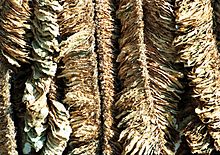
Back Tabak Afrikaans Tabak ALS ትምባሆ Amharic Tamako^ AMI Tabaco AN Pīpwēod ANG तंबाकु ANP تبغ شائع Arabic ধঁপাত Assamese Tabacu AST
| Tobacco | |
|---|---|
 Tobacco flakes, sliced from pressed plugs | |
| Source plant(s) | Nicotiana |
| Part(s) of plant | Leaf |
| Geographic origin | The Americas |
| Active ingredients | Nicotine, harmine |
| Uses | Recreational, Sacred, Medical, Religious, Traditional, Peacemaking |
| Legal status |
|
| Part of a series on |
| Tobacco |
|---|
 |


Tobacco is the common name of several plants in the genus Nicotiana of the family Solanaceae, and the general term for any product prepared from the cured leaves of these plants. More than 70 species of tobacco are known, but the chief commercial crop is N. tabacum. The more potent variant N. rustica is also used in some countries.
Dried tobacco leaves are mainly used for smoking in cigarettes and cigars, as well as pipes and shishas. They can also be consumed as snuff, chewing tobacco, dipping tobacco, and snus.
Tobacco contains the highly addictive stimulant alkaloid nicotine as well as harmala alkaloids.[1] Tobacco use is a cause or risk factor for many deadly diseases, especially those affecting the heart, liver, and lungs[2] as well as many cancers. In 2008, the World Health Organization named tobacco use as the world's single greatest preventable cause of death.[3]

- ^ Rudgley R (1998). "Tobacco". The Encyclopaedia of Psychoactive Substances. London: Little, Brown and Company. ISBN 978-0-316-64347-4. OCLC 39129000. Archived from the original on September 27, 2022. Retrieved November 26, 2017.
- ^ CDC. "What Are the Risk Factors for Lung Cancer?". Retrieved March 31, 2024.
- ^ WHO Report on the Global Tobacco Epidemic 2008 : The MPOWER Package (PDF). World Health Organization. 2008. pp. 6, 8, 20. ISBN 978-92-4-068311-2. OCLC 476167599. Archived from the original (PDF) on January 21, 2022. Retrieved October 6, 2022.
Tobacco is the single most preventable cause of death in the world today.